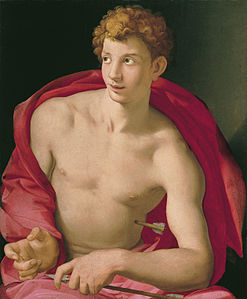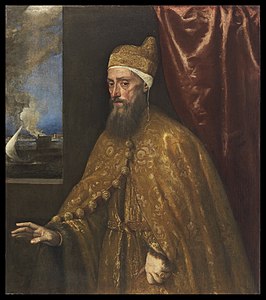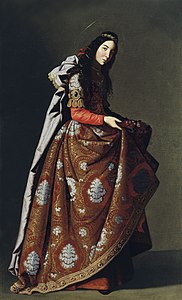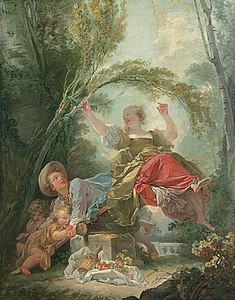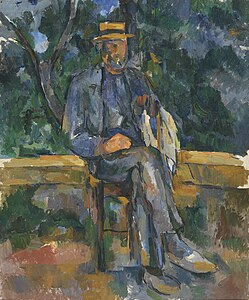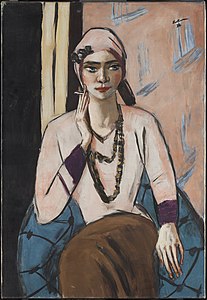Thyssen-Bornemisza Museum
Museo Nacional Thyssen-Bornemisza | |
Heinrich, Baron Thyssen-Bornemisza de Kászon | |
| Director | Guillermo Solana (Artistic Director), Evelio Acevedo (Managing Director) |
|---|---|
| Website | www.museothyssen.org |
The Thyssen-Bornemisza National Museum (Spanish: Museo Nacional Thyssen-Bornemisza, pronounced
With over 1,600 paintings, it was once the second largest private collection in the world after the British Royal Collection.[2] A competition was held to house the core of the collection in 1987–88 after Baron Thyssen, having unsuccessfully sought permission to enlarge his museum in Lugano (Villa Favorita), searched for a better-suited location elsewhere in Europe.
History

The collection was started in the 1920s as a private collection by
The collection was initially housed in the family estate in Lugano in a twenty-room building modelled after the Neue Pinakothek in Munich. In 1988, the Baron filed a request for building a further extension designed by British architects James Stirling and Michael Wilford, but the plan was rejected by the Lugano City Council.
In 1985, the Baron married Carmen "Tita" Cervera (a former Miss Spain 1961) and introduced her to art collecting. Cervera's influence was decisive in persuading the Baron to relocate the core of his collection to Spain where the local government had a building available next to the Prado. The Thyssen-Bornemisza Museum officially opened in 1992, showing 715 works of art. A year later, the Spanish Government bought 775 works for $350 million.[4] These pieces are now in the purpose-built museum in Madrid. After the museum opened, in 1999, Cervera loaned 429 works of her own art collection to the museum for 11 years. The loan was renewed annually for free from 2012 to 2021.[4]
The Baroness remains involved with the museum. She personally decided the
In 2015, the Baroness delayed the annual renewal of her loan while deciding whether or not to temporarily move her collection for a fee to a museum in Barcelona, the United States, or Russia. She eventually decided to keep the collection in Madrid, but in 2017, she again delayed signing the agreement. In 2021, the Ministry of Culture officially finalized an agreement to loan the collection for an annual fee of 6.5 million euros ($7.8 million) over the course of 15 years.[5]
The collection

The Old Masters were mainly bought by the elder Baron, while Hans focused more on the 19th and 20th century, resulting in a collection that spans eight centuries of European painting, without claiming to give an all-encompassing view but rather a series of highlights.

One of the focal points is the early European painting, with a major collection of trecento and quattrocento (i.e. 14th and 15th century) Italian paintings by Duccio, Luca di Tommè, Bernardo Daddi, Paolo Uccello, Benozzo Gozzoli and his contemporaries, and works of the early Flemish and Dutch painters like Jan van Eyck (Diptich of the Annunciation), Petrus Christus (Madonna of the Dry Tree), Robert Campin, Rogier van der Weyden, Gerard David and Hans Memling.
Other highlights include works by leading
The Museum houses a display of North American paintings from 18th and 19th centuries, including Copley, Winslow Homer, John Singer Sargent.

The display of the European 19th century starts with works by
A collection of works from the museum (Fra Angelico, Cranach, Titian, Canaletto, Rubens) is housed in Barcelona in the Museu Nacional d'Art de Catalunya.
One painting,
Selected collection highlights
-
Flowers in a Jug, Hans Memling
-
Christ among the Doctors (Dürer)
-
Portrait of a lady,Hans Baldung Grien
-
The Nymph of the Fountain, Lucas Cranach the Elder
-
Portrait of Jacques Le Roy, Anthony van Dyck
-
Saint Sebastian, Bronzino
-
Portrait of Dux Francesco Venier, Titian
-
Santa Casilda,Zurbarán
-
Self-portrait wearing a Hat and two Chains, Rembrandt
-
Vase with flowers, Balthasar van der Ast
-
The Piazza San Marco in Venice, Canaletto
-
Swaying Dancer (Dancer in Green), Edgar Degas
-
Woman with a Parasol in a Garden, Pierre-Auguste Renoir
-
The Thaw at Vétheuil, Claude Monet
-
Les Vessenots à Auvers, Vincent van Gogh
-
Seated Man, Paul Cézanne
-
Mata Mua, Paul Gauguin
-
La Rousse in a White Blouse, Henri de Toulouse-Lautrec
-
Portrait of Millicent Leveson-Gower, Duchess of Sutherland, John Singer Sargent
-
Fränzi before a carved chair, Ernst Ludwig Kirchner
-
The dream, Franz Marc
-
Häuser am Fluss, Egon Schiele
-
Quappi in Pink Jumper, Max Beckmann
-
Girl at a Sewing Machine, Edward Hopper
Sales
In 2011, due to "a lack of liquid funds", Cervera decided to sell The Lock by the English artist John Constable.[11][12] The painting, which belonged to her private collection, was sold in London the following year for £22.4 million, more than doubling the price paid for it in 1990.[13]
See also
Notes
Further reading
- José Manuel Pita Andrade & María del Mar Barochia Guerrero. Maestros antiguos del Museo Thyssen-Bornemisza. 1994. 3a ed. Lunwerg editores. 1994. 815 pp. ISBN 84-88474-02-4
References
- ^ "Visitor Figures 2015" (PDF). The Art Newspaper. Retrieved 1 December 2016.
- ^ a b Jonathan Kandell, "Baron Thyssen-Bornemisza, Industrialist Who Built Fabled Art Collection, Dies at 81," New York Times, 28 April 2002.
- ISBN 84-88474-48-2.
- ^ a b Laurie Rojas (February 2, 2015), Thyssen-Bornemisza keeps Spain in suspense over loan Archived 2015-02-04 at the Wayback Machine The Art Newspaper.
- ^ Shanti Escalante-De Mattei (June 29, 2021), Spain Finalizes Agreement to Pay to Keep Baroness Thyssen's Collection in Madrid ARTnews.
- ^ Cascone, Sarah (6 December 2016). "Art and Law Case Over $30 Million Camille Pissarro Painting Comes to a Head in Appeals Court". Artnet.com. Artnet Worldwide Corp. Retrieved 5 May 2017.
- ^ a b Torok, Ryan (December 12, 2016). "Pasadena trial focuses on Nazi-looted masterpiece". The Jewish Journal of Greater Los Angeles. Retrieved December 13, 2016.
- ISSN 0458-3035. Retrieved 2017-04-24.
- ^ "Judge rules museum 'rightfully owns' Nazi-looted painting". BBC News. May 2019. Retrieved 1 May 2019.
- ^ Sneed, Tierney (18 January 2022). "Pissarro painting confiscated by Nazis at center of Supreme Court arguments". CNN. Retrieved 2022-01-25.
- ^ Brown, Mark (2012). "John Constable's The Lock to be sold at auction". The Guardian. Retrieved June 23, 2012.
- ^ Garcia, Angeles (2012). "No soy gastosa. Los ricos también están en crisis". Retrieved June 23, 2012.
- ^ "Constable's The Lock sells for a record £22.4million". The Telegraph.
External links
- Official website
- EducaThyssen website of the Research and Further Studies Department
- Virtual tour of the Thyssen-Bornemisza Museum provided by Google Arts & Culture
 Media related to Museo Thyssen-Bornemisza at Wikimedia Commons
Media related to Museo Thyssen-Bornemisza at Wikimedia Commons











